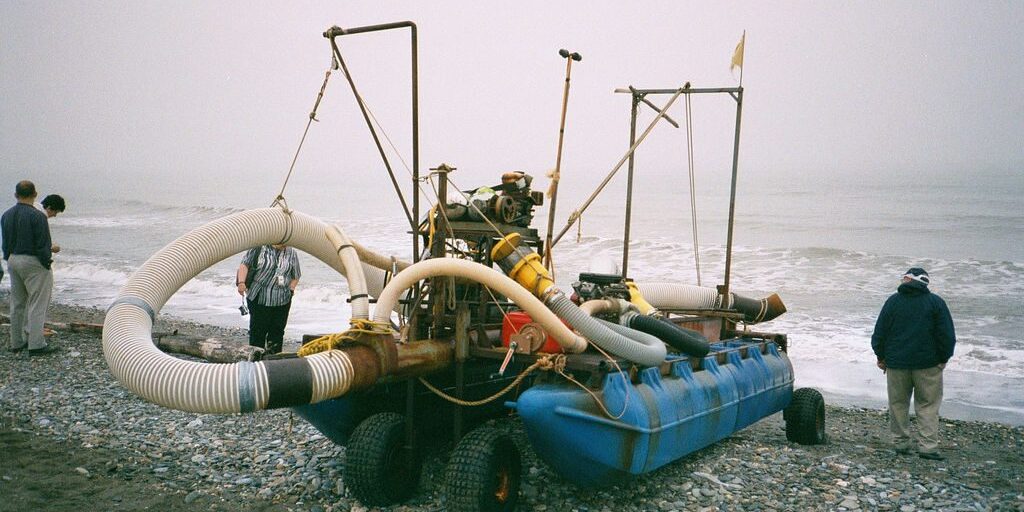IPOP LLC, the company registered with a proposed mining project in the Safety Sound area outside of Nome, has amended their request to operate a test dredge this month. They now have permission from one agency to do exploratory work for a two-week period between August 15 and October 31.
The Alaska Department of Fish & Game has authorized IPOP to gather baseline data using a six-inch suction dredge at three claims in the Bonanza River Channel between the main Safety Sound and the Bonanza River, but not within the river itself. According to the regional supervisor for ADF&G’s Division of Habitat, Audra Brase, the department issued the fish habitat permit last week on August 6.
Brase says the permit for this exploration process also allows IPOP to drill two-inch holes about 30 or so feet within the sediment to take core samples. The permit authorizes this activity to take place at 50 sites in the channel east of the Solomon River outlet. According to the permit, IPOP’s test project, as proposed, “should not have adverse effects on anadromous fish or their habitat and should not obstruct the free passage of fish.”
According to Brase, even though the fish habitat permit has been issued, IPOP still needs to obtain authorization from the Alaska Department of Natural Resources and the U.S. Army Corps of Engineers before starting their drilling and other amended work.
Nome resident Howard Farley, Jr. (a.k.a. “Chugie”), has commercially fished in that same area for years. He believes the work IPOP proposes to do will negatively impact the fish he and many others rely on in the Safety Sound.
“It’s a sound, it’s not a river — so the river doesn’t flow through there, it just comes up and down with the tide, so it’s real silty. Fish will swim through there to get to the river, but having no silt and clean water is what the fish want; they don’t want to breathe the dirty water. So that’s one problem they have not addressed yet.”
Farley went on to say that it doesn’t matter when the company plans to do their suction test-dredging: he still feels there is no purpose for the project if there is no gold there.
In an email obtained by KNOM, Edwin Epstein, a general partner with Rivers of Gold who is also listed under the original Application for Permits to Mine in Alaska (APMA) from last year, said there is no TV show surrounding the test dredging. Their exploration is to fulfill study requirements from the state, and their permit application in this case is not for mining.
Colby Engstrom, a resident and miner who lives about four miles away from the area where IPOP has proposed drilling, says he’s had interactions with representatives from the company, including Epstein. According to Engstrom, regardless of IPOP’s intentions for the test dredge itself, their overall project goals are focused on revenue from Rivers of Gold TV shows and merchandise.
“In my two-hour Skype conversation with Mr. Epstein, he reiterated over and over again that they know that the resource isn’t the greatest, but the amount of money they stand to make via the merchandising and the sale of the TV show is what drives this project forward. They anticipate doing $40 to $400 million a year in merchandise and revenue stemming from the TV show.”
Engstrom was previously approached by IPOP to negotiate the sale of two of his mining claims to the company, but negotiations broke down, and nothing was finalized. During that time, he says he was given a spreadsheet from the company stating they anticipated only getting $20 million from Engstrom’s two mining claims, compared to the over $400 million from merchandising.
An IPOP partner, Epstein, could not be reached for further comment before the airing of this story.
Charlene Bringhurst with the DNR confirms that IPOP is authorized to operate the six-inch suction dredge to study turbidity plume characteristics and gather environmental baseline data before October 31st. Their access point to launch equipment is described as the “boat launch” near the Safety Sound bridge. According to Leslie Tose with the Corps, IPOP does not have authorization from their agency yet to conduct other activities. They must do an Endangered Species consultation before any new proposed work can start.
According to Brase, when IPOP’s exploratory work with a six-inch suction dredge does begin, employees from the Nome Fish and Game office plan to occasionally monitor their activities as the department does aerial surveys in the area.
Image at top: file photo: a gold dredge on the Bering Sea. (This image is meant to be representative of the general subject matter of this story — i.e., gold dredging in Western Alaska — but is not an exact depiction of the equipment IPOP would be using in Safety Sound.) Photo: Paula Braga, Creative Commons.




